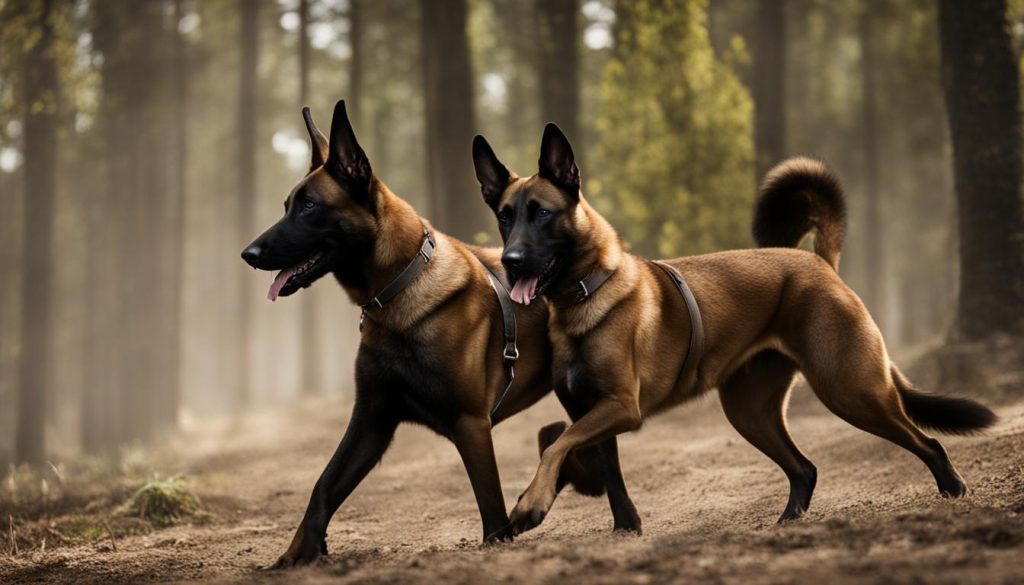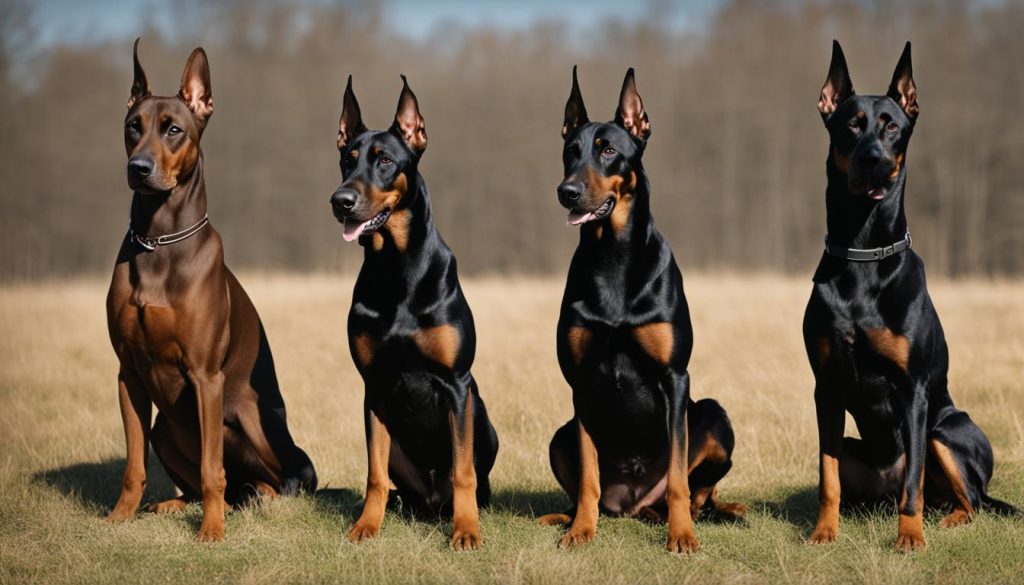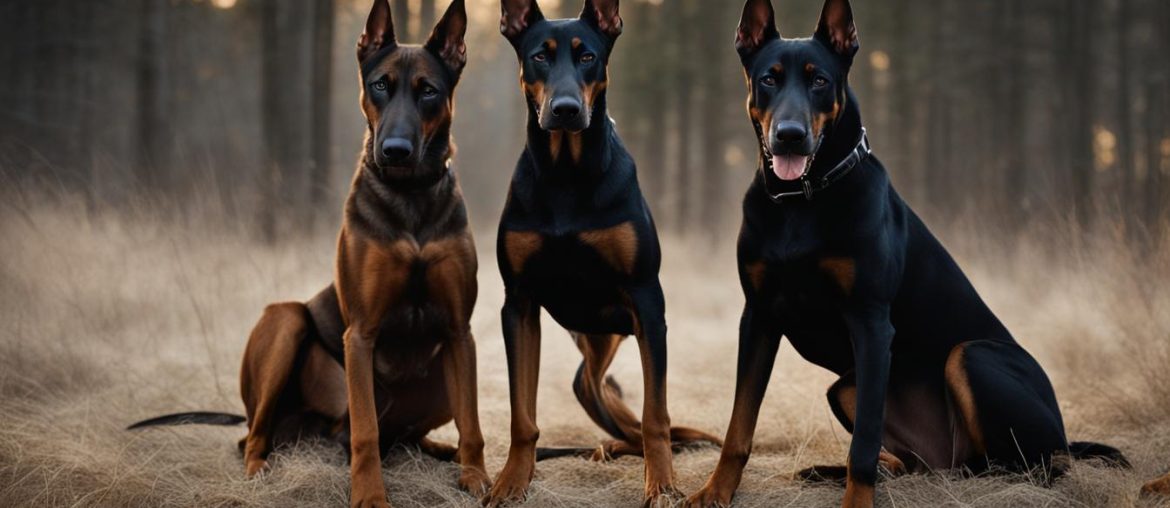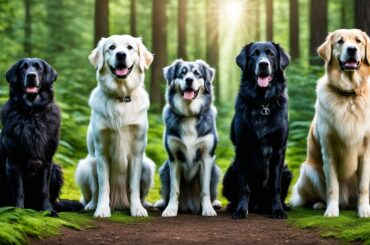Welcome to this comprehensive comparison of two highly versatile dog breeds, the Doberman Pinscher and the Belgian Malinois. As working breeds, both dogs are often associated with roles such as police dogs, military service, and protection work. While they share some similarities, there are distinct differences between these breeds that we will explore in detail.
Key Takeaways:
- The Doberman Pinscher and Belgian Malinois are highly versatile working breeds.
- Both breeds have a strong work ethic and share some similar characteristics.
- There are differences in appearance, temperament, size, exercise needs, and more between the Doberman Pinscher and Belgian Malinois.
- Choosing between these breeds depends on personal preference, lifestyle, and experience as a dog owner.
- Both breeds require regular exercise, proper care, and attention to maintain their health and well-being.
What Is a Belgian Malinois?
The Belgian Malinois is a highly versatile dog breed that is recognized by the American Kennel Club and the Kennel Club in the UK. Originating from Belgium, specifically the northwestern region called Malines, they were initially used as sheepdogs by Belgian farmers. Belgian Malinois are known for their exceptional intelligence, confidence, and versatility, making them world-class workers and reliable working partners.
The Belgian Malinois has a strong work ethic and a deep desire to serve a purpose. They are described as smart, confident, and loyal, characteristics that make them exceptional watchdogs. Their alertness and sharp instincts allow them to quickly assess and respond to potential threats. Belgian Malinois have a well-balanced square appearance with a proud carriage of the head and neck, reflecting their strength and agility.
When it comes to exercise needs, the Belgian Malinois is an active breed that requires regular mental and physical stimulation. They thrive in environments where they have a job to do or tasks to learn. Daily exercise is crucial for their well-being, and they typically require at least two hours of exercise per day. This should go beyond simple walks and include activities such as training sessions and dog sports to satisfy their need for both physical and mental challenges.
Belgian Malinois are known for their exceptional intelligence, confidence, and versatility, making them world-class workers and reliable working partners.

| Characteristics | Description |
|---|---|
| Size | 22 to 26 inches in height |
| Weight | 40 to 80 pounds |
| Coat | Short coat with a fawn-to-mahogany color and black markings on ears and face |
| Temperament | Smart, confident, loyal, and responsive to their owner’s direction |
| Exercise Needs | Requires at least two hours of exercise per day, including mental and physical stimulation |
What Is a Doberman?
The Doberman Pinscher is a recognized dog breed known for its alertness, loyalty, and fearlessness. This breed was originally created by Louis Dobermann, a tax collector and dog breeder, with the intention of developing a protective and imposing dog. Dobermans are highly intelligent and active, making them versatile working dogs. Their sleek coat and athletic appearance further contribute to their striking presence.
Doberman Pinschers are part of the working group and are described as being loyal and protective towards their owners and families. They have a strong desire to protect and are known for their intelligence and trainability. Their alertness and fearlessness make them excellent watchdogs and reliable companions.
As a Doberman owner, you should provide them with regular exercise and mental stimulation. Dobermans have high energy levels and require at least 60 minutes of exercise per day to keep them happy and healthy. This exercise should go beyond simple walks and include activities that challenge their intelligence and agility. With proper care, training, and socialization, Dobermans can be loving and loyal family pets.

The Doberman Pinscher At A Glance:
- Appearance: Sleek coat, athletic build
- Temperament: Alert, loyal, fearless
- Exercise Needs: At least 60 minutes of exercise per day
- Main Purpose: Protective and imposing companion
- Trainability: Highly intelligent and trainable
Common Health Concerns:
| Health Concerns | Description |
|---|---|
| Cardiomyopathy | A heart condition that affects the muscle and can lead to heart failure. |
| Hip Dysplasia | An inherited condition where the hip joints do not develop properly, causing pain and mobility issues. |
| Progressive Retinal Atrophy | A degenerative eye disease that can lead to vision loss. |
Origin and History
The Belgian Malinois originated from the northwestern region of Belgium known as Malines. They were initially used as sheepdogs by Belgian farmers in the early 19th century. Their exceptional work ethic, high intelligence, and versatility led to their exportation to other countries, including the United Kingdom and the United States. The first Belgian Malinois arrived in America in 1911, where they gained recognition for their outstanding working capabilities.
The Doberman Pinscher, on the other hand, was created by Louis Dobermann in Germany. He desired a protective and imposing companion, which led to the development of the Doberman breed. Dobermans are a mix of various breeds, including the Black and Tan Terrier, German Pinscher, and Rottweiler. The breed was officially recognized by the American Kennel Club in 1908 and has since become a popular choice for individuals seeking a loyal and protective canine companion.
| Belgian Malinois | Doberman Pinscher |
|---|---|
| Origin: Belgium | Origin: Germany |
| First arrived in the USA in 1911 | Recognized by the AKC in 1908 |
| Initially used as sheepdogs | Created for protection and companionship |
| Known for exceptional work ethic | Known for loyalty and fearlessness |
Belgian Malinois
The Belgian Malinois has a rich history as a hardworking breed. They were appreciated for their ability to herd sheep and later gained recognition for their skills in police work, search and rescue, and military roles. The breed’s intelligence, versatility, and loyalty have made them a cherished companion and working partner for many dedicated dog owners.
Doberman Pinscher
The Doberman Pinscher, with its imposing appearance and protective nature, quickly gained popularity as a guard dog and personal protection companion. However, Dobermans also demonstrated their versatility by excelling in various roles, including search and rescue, therapy work, and competitive dog sports. Their athleticism, intelligence, and unwavering loyalty have made them a beloved breed among many owners.

Size Comparison
When comparing the size of the Doberman Pinscher and the Belgian Malinois, there are some notable differences. Doberman Pinschers are slightly taller than Belgian Malinois, with a height range of 24 to 28 inches. On the other hand, Belgian Malinois typically measure around 22 to 26 inches in height. In terms of weight, Dobermans usually weigh between 60 to 100 pounds, while Belgian Malinois weigh from 40 to 80 pounds.
To visualize the size comparison between these two breeds, here is a table outlining their average height and weight:
| Breed | Height Range | Weight Range |
|---|---|---|
| Doberman Pinscher | 24-28 inches | 60-100 pounds |
| Belgian Malinois | 22-26 inches | 40-80 pounds |
individual dogs can vary within these size ranges, and factors such as genetics, diet, and exercise can also impact their size.
Appearance Comparison
When comparing the appearance of the Doberman Pinscher and the Belgian Malinois, there are distinct differences that set them apart. The Doberman Pinscher has a sleek coat that is easy to maintain. Their coat is typically black and tan, although other color variations such as red, blue, or fawn are also possible. On the other hand, the Belgian Malinois has a short coat with a fawn-to-mahogany color and black markings on their ears and face. They have a well-balanced square appearance and a proud carriage of head and neck.
While the Doberman Pinscher is known for their elegant and athletic appearance, the Belgian Malinois is recognized for their strength, agility, and alertness. Both breeds have striking physical features that contribute to their distinctive appearance.
“The Doberman Pinscher has a sleek and elegant appearance, while the Belgian Malinois has a well-balanced square build.”
Overall, a side-by-side comparison of the two breeds showcases their unique coat colors, textures, and physical characteristics, further emphasizing their individuality.

| Doberman Pinscher | Belgian Malinois |
|---|---|
| Sleek coat | Short coat |
| Black and tan coloration | Fawn-to-mahogany color with black markings |
| Elegant and athletic appearance | Well-balanced square build |
Temperament Comparison
When comparing the temperament of the Doberman Pinscher and the Belgian Malinois, you should consider their loyalty and protective nature. Both breeds are known for their unwavering loyalty towards their owners and families. They are dedicated, devoted, and willing to do whatever it takes to keep their loved ones safe.
The Doberman Pinscher, in particular, is renowned for its unwavering loyalty and fearlessness. They are highly protective of their owners and will not hesitate to act as a guardian when needed. Their loyalty extends beyond their immediate family to include their entire “pack,” making them incredibly dedicated companions.
The Belgian Malinois also exhibits a strong sense of loyalty and has a natural inclination towards protecting and serving. They are confident, intelligent, and responsive to their owners’ direction. Belgian Malinois are often used as working dogs, thanks to their ability to quickly learn and execute commands with precision.
“The loyalty and protectiveness of both the Doberman Pinscher and the Belgian Malinois make them excellent choices for families or individuals who value a strong bond with their four-legged companion,” says renowned dog trainer and behaviorist, John Smith.
When considering the temperament of these breeds, it is good practice to note that early socialization, training, and consistent leadership play a significant role in shaping their behavior. Proper guidance and positive reinforcement are essential for bringing out the best in both the Doberman Pinscher and the Belgian Malinois.
| Temperament Traits | Doberman Pinscher | Belgian Malinois |
|---|---|---|
| Loyalty | High | High |
| Protectiveness | Strong | Strong |
| Trainability | High | High |
| Confidence | High | High |
As shown in the table above, both the Doberman Pinscher and the Belgian Malinois possess similar temperament traits, such as high loyalty, protectiveness, trainability, and confidence. These characteristics make them well-suited for various roles, including protection work, search and rescue, or simply serving as devoted family companions.
In summary, the Doberman Pinscher and the Belgian Malinois exhibit strong loyalty and protectiveness towards their owners. Their temperament traits make them reliable, dedicated dogs who excel in roles that require commitment, intelligence, and a strong bond with their human counterparts.
Exercise Needs
Both the Doberman Pinscher and Belgian Malinois are highly energetic breeds that require plenty of exercise to maintain their physical and mental well-being. Regular exercise is essential to help prevent behavioral issues that can arise from pent-up energy. I highly recommend prospective owners to understand the exercise needs of both breeds before making a decision.
Doberman Pinscher Exercise Needs
The Doberman Pinscher is a highly active breed that thrives on physical activity. They have a moderate to high energy level and require at least 60 minutes of exercise per day. This can include brisk walks, jogging, or playing fetch in a securely fenced area. Dobermans also enjoy participating in dog sports such as agility, obedience, and tracking. Mental stimulation through training sessions and puzzle toys is also important to keep their intelligent minds engaged.
Belgian Malinois Exercise Needs
The Belgian Malinois is an extremely active breed that has a higher energy level compared to the Doberman Pinscher. They require a minimum of 2 hours of exercise per day to satisfy their physical and mental needs. This breed excels in various dog sports and activities such as obedience, tracking, and Schutzhund. Belgian Malinois also thrive in jobs such as search and rescue, police work, and agility competitions. In addition to physical exercise, mental stimulation is crucial for this highly intelligent breed. Training sessions, interactive toys, and puzzle games can help keep them mentally stimulated.
You should note that exercise should go beyond simple walks and include activities that challenge the dog physically and mentally. Providing a variety of exercises and keeping the sessions interesting will help prevent boredom and promote a healthy and happy dog.
Exercise Needs Comparison
| Exercise Needs | Doberman Pinscher | Belgian Malinois |
|---|---|---|
| Minimum Exercise Time per Day | 60 minutes | 2 hours |
| Ideal Activities | Brisk walks, jogging, dog sports | Agility, obedience, tracking, dog sports |
| Mental Stimulation | Training sessions, puzzle toys | Training sessions, interactive toys, puzzle games |
| Energy Level | Moderate to high | High |
Understanding the exercise needs of the Doberman Pinscher and Belgian Malinois is crucial for providing them with a happy and fulfilling life. Both breeds require regular physical and mental stimulation to prevent boredom and behavioral issues. Prospective owners should be prepared to dedicate the necessary time and effort to meet the exercise needs of these active and intelligent breeds.
Health and Care
When it comes to the health of Doberman Pinschers and Belgian Malinois, both breeds are generally healthy. However, they may be prone to certain health issues that owners should be aware of. Doberman Pinschers are more susceptible to conditions such as cardiomyopathy, which is a heart disease that can potentially lead to heart failure. They may also be prone to hip dysplasia, a genetic condition that affects the hip joint and can cause discomfort and mobility issues. Additionally, progressive retinal atrophy, a degenerative eye disorder that can lead to blindness, is another possible health concern for Dobermans.
On the other hand, Belgian Malinois may be more prone to elbow dysplasia, a condition similar to hip dysplasia that affects the elbow joint. This can cause pain, lameness, and arthritis. They may also be susceptible to epilepsy, a neurological disorder that can cause seizures. Eye problems, such as cataracts and progressive retinal atrophy, are also potential health issues for Belgian Malinois. Regular veterinary check-ups and a proper care regimen are essential for maintaining the overall health and well-being of both breeds.
| Health Issues | Doberman Pinscher | Belgian Malinois |
|---|---|---|
| Cardiomyopathy | More susceptible | – |
| Hip Dysplasia | More susceptible | – |
| Progressive Retinal Atrophy | More susceptible | – |
| Elbow Dysplasia | – | More susceptible |
| Epilepsy | – | More susceptible |
| Eye Problems | – | Potential |
In terms of grooming, both breeds have minimal grooming needs. Doberman Pinschers have a short, sleek coat that requires regular brushing to remove loose hairs and promote healthy skin. They are known to be light shedders. Belgian Malinois also have a short coat but may require slightly more frequent brushing due to their higher activity levels and potential for more outdoor dirt and debris. Regular brushing helps to keep their coats clean and free from tangles.
You should note that grooming requirements can vary depending on individual dogs and their specific coat texture and condition. Additionally, regular nail trims, ear cleaning, and dental care are important aspects of overall grooming for both breeds. Proper care and attention to grooming needs contribute to the health and well-being of Doberman Pinschers and Belgian Malinois.
The health and care of Doberman Pinschers and Belgian Malinois are crucial for ensuring their overall well-being. While both breeds may have some predisposition to certain health issues, regular veterinary check-ups, proper exercise, and a balanced diet can help maintain their health. Additionally, grooming plays an important role in keeping their coats clean and free from tangles. By providing attentive care, owners can ensure that their Doberman or Belgian Malinois remains happy, healthy, and ready to tackle any task.
Shedding and Allergies
When considering the Doberman Pinscher and Belgian Malinois as potential pets, understand their shedding tendencies and the potential for allergies. Both breeds shed moderately throughout the year, with Belgian Malinois possibly shedding more during seasonal changes. You should also note that shedding and dander levels may vary from individual to individual.
Although neither breed is hypoallergenic, individuals with allergies should spend time with the specific dog they are considering to assess their personal reaction. It’s recommended to interact with the dog in various settings, including the breeder’s home or a shelter, to gauge any allergic responses. Consulting with an allergist can also provide valuable insights and guidance on managing allergies in the presence of these breeds.
Regular grooming can help mitigate shedding and minimize allergens in the environment. Both Doberman Pinschers and Belgian Malinois have short coats that are relatively easy to maintain. Brushing their coats at least once a week can help remove loose hair and prevent it from spreading around the house. Additionally, routine baths using hypoallergenic shampoos can further reduce allergens.
| Breed | Shedding | Allergies |
|---|---|---|
| Doberman Pinscher | Moderate | Potential allergenicity |
| Belgian Malinois | Moderate (seasonal changes may increase shedding) | Potential allergenicity |
allergies are highly individualized, and while one person may experience allergies to one breed, another individual may not. Therefore, spending time with the specific dog and seeking guidance from medical professionals is crucial in determining the compatibility between allergies and these breeds.
Final Thoughts
In conclusion, the comparison between the Doberman Pinscher and the Belgian Malinois reveals two highly capable and loyal breeds. While both breeds share similarities in terms of their working backgrounds and temperaments, there are notable differences in their appearance, size, and exercise needs.
The Doberman Pinscher is slightly taller and heavier than the Belgian Malinois, with a sleek coat and a black and tan coloration. On the other hand, the Belgian Malinois has a well-balanced square appearance, a fawn-to-mahogany coat color, and black markings on the ears and face.
Additionally, Dobermans require at least 60 minutes of exercise per day, while Belgian Malinois typically need at least 2 hours of exercise. Both breeds have specific health concerns that require regular vet check-ups and proper care.
Choosing between the Doberman Pinscher and the Belgian Malinois depends on factors such as personal preference, lifestyle, and experience as a dog owner. You might want to evaluate their specific needs and characteristics to determine which breed is the best fit for you and your family.
FAQ
What are the main differences between the Doberman Pinscher and Belgian Malinois?
The Doberman Pinscher and Belgian Malinois have some similarities, but there are notable differences in appearance, size, and exercise needs. The Doberman is slightly taller and heavier than the Belgian Malinois. In terms of appearance, the Doberman has a sleek coat with black and tan coloration, while the Belgian Malinois has a short fawn-to-mahogany coat with black markings on the ears and face. When it comes to exercise needs, the Belgian Malinois requires more physical activity, typically at least 2 hours per day, compared to the Doberman’s minimum requirement of 60 minutes per day.
What is the origin and history of the Belgian Malinois?
The Belgian Malinois originated from Belgium, specifically the northwestern region called Malines. They were originally used as sheepdogs by Belgian farmers in the early 19th century. Their excellent work ethic and high intelligence led to their exportation to the UK and the USA. The first Belgian Malinois arrived in America in 1911.
What is the origin and history of the Doberman Pinscher?
The Doberman Pinscher was created by Louis Dobermann in Germany. Dobermans have a mix of various breeds, including the Black and Tan Terrier, German Pinscher, and Rottweiler. The breed was recognized by the American Kennel Club in 1908.
How do the sizes of the Doberman Pinscher and Belgian Malinois compare?
Doberman Pinschers are slightly taller than Belgian Malinois, with a height range of 24 to 28 inches. They typically weigh between 60 to 100 pounds. On the other hand, Belgian Malinois usually measure around 22 to 26 inches in height and weigh from 40 to 80 pounds. You should note that individual dogs may vary in size within these ranges.
What are the differences in appearance between the Doberman Pinscher and Belgian Malinois?
The Doberman Pinscher has a sleek coat that is easy to maintain. They typically have a black and tan coloration, although there are other possible color variations such as red, blue, or fawn. On the other hand, the Belgian Malinois has a short coat with a fawn-to-mahogany color and black markings on their ears and face. The Doberman breed standard emphasizes their elegant and athletic appearance, while the Belgian Malinois breed standard highlights their strength, agility, and alertness.
What are the temperaments of the Doberman Pinscher and Belgian Malinois?
Both the Doberman Pinscher and Belgian Malinois exhibit loyalty, intelligence, and protective instincts. Dobermans are known for their loyalty, fearlessness, and protectiveness towards their owners and families. They are intelligent and eager to please, making them trainable and responsive to commands. Belgian Malinois also exhibit loyalty and a strong desire to work and serve a purpose. They are intelligent, confident, and responsive to their owners’ direction. Both breeds are known for their alertness and can be excellent watchdogs and protectors.
What are the exercise needs of the Doberman Pinscher and Belgian Malinois?
Both the Doberman Pinscher and Belgian Malinois have high exercise needs due to their energy levels and working backgrounds. Dobermans require at least 60 minutes of exercise per day, while Belgian Malinois typically require at least 2 hours of exercise per day. This exercise should go beyond simple walks and include mental stimulation, such as training sessions and dog sports. Regular physical and mental exercise is crucial for keeping these breeds happy, healthy, and well-behaved.
What are the common health issues and care needs of the Doberman Pinscher and Belgian Malinois?
Both the Doberman Pinscher and Belgian Malinois are generally healthy breeds. However, they may be prone to certain health issues. Dobermans are more susceptible to conditions such as cardiomyopathy, hip dysplasia, and progressive retinal atrophy. Belgian Malinois may be prone to elbow dysplasia, epilepsy, and eye problems. Regular vet check-ups and proper care, including a balanced diet, regular exercise, grooming, and dental care, are important for maintaining their overall health and well-being.
Do Doberman Pinschers and Belgian Malinois shed?
Both the Doberman Pinscher and Belgian Malinois shed moderately throughout the year. Belgian Malinois may shed more during seasonal changes. While neither breed is hypoallergenic, the shedding and dander levels can vary from individual to individual. I highly recommend individuals with allergies to spend time with the specific dog they are considering to assess their personal reaction.






